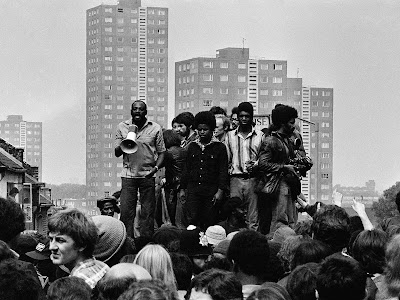A new mural was unveiled last month at Goldsmiths commemorating the August 1977 'Battle of Lewisham' when anti-fascists mobilised to oppose a march by the far right National Front from New Cross to Lewisham. Designed by Ted Low in collaboration with local community groups, the mural is a montage of images from photographs taken on the day - including the 'All Lewisham Campaign Against Racism and Fascism' banner and clashes in New Cross Road and Lewisham town centre.
At the centre of the mural, holding a megaphone, is Darcus Howe. At that time editor of Brixton-based Race Today magazine, he was to play an important role in the movement after the New Cross Fire a few years later in 1981. The image comes from a photograph by Syd Shelton showing Darcus Howe standing on top of the public toilets on Clifton Rise.
Another photo taken around the same time facing in the other direction shows the crowd on New Cross Road, with New Cross Inn behind the speaker and across the road the site of what is now The Word Bookshop on corner of Laurie Grove (somebody in front row holding up a cassette recorder - would be great if tape of speeches still exists!).
The toilets get a mention in an Irish Times (13/8/1977) report on preparations for the demonstration : 'A public convenience in Clifton Rise, Deptford is to be used as a cell-block if there is widespread violence, the attendant, Mr Ron Edwards, has been told. Right-wingers would be led to the Gentlemen and Left-wingers to the Ladies'. The same report mentioned that 'For the first time police will have the use of special riot gear, heavy duty plastic shields and helmets'. The mural includes an image of the riot shields in use in Lewisham town centre, their first deployment in the UK outside of Northern Ireland. But with thousands of anti-fascists blockading Clifton Rise, any plans to use the toilets (if true) must have been abandoned.
The mural launch at Goldsmiths on 26 October 2019 also included a reception with reggae DJ set from Tessa Pollitt, former bassist with The Slits.
There were a view veterans from 1977 present, including photographer Homer Sykes whose work is also featured in the mural. A collection of his photographs from the day has been been published by Cafe Royal Books.
According to the radical philosopher Alain Badiou, a feature of a historically significant Event is that it inspires a kind of 'fidelity' amongst those inspired by it, a loyalty to its purposes that is ongoing rather than a historical memory of a frozen past. Lewisham '77 has certainly inspired such fidelity, with a series of local events to mark its 30th anniversary (in 2007) and 40th anniversary (in 2017) explicitly relating the 1977 demonstration to contemporary struggles against racism and the far right.
Dr John Price, Head of the Department of History at Goldsmiths, said: “This vivid public artwork, commemorating an important event in the history of anti-fascism and anti-racism in the UK, will stand as a permanent reminder of what can be achieved when communities come together to resist and oppose bigotry in all its forms. The Battle of Lewisham was south London’s Battle of Cable Street and it is fitting that both events are now marked with commemorative plaques and major pieces of public art.” The mural is displayed on the side of the Goldsmith library on Lewisham Way.
There's lots about Lewisham 1977 on this blog, my main reflections on it are in an article I wrote for Datacide magazine: Lewisham '77: myth and anti-fascist history. For everything else at Transpontine scroll through here































